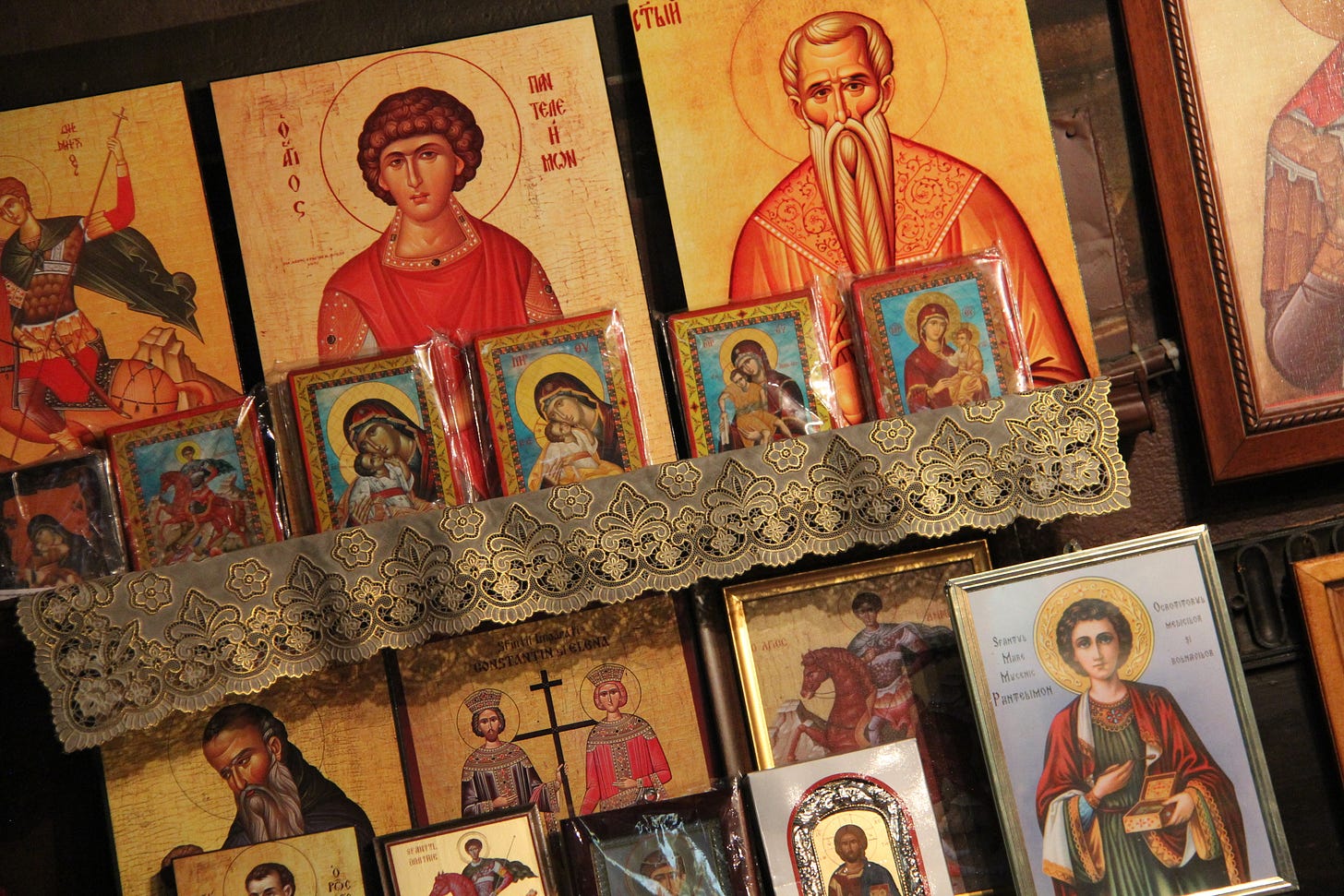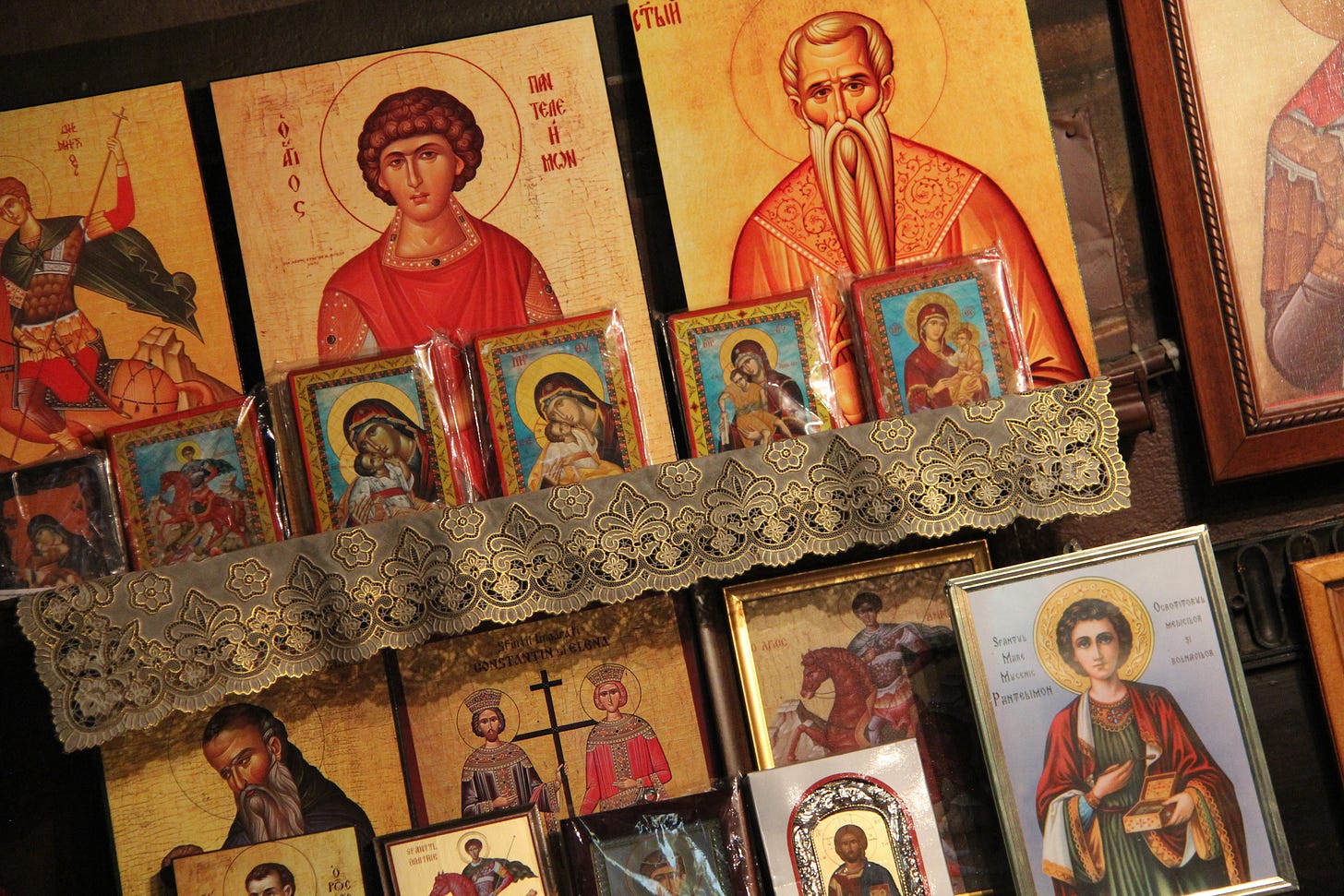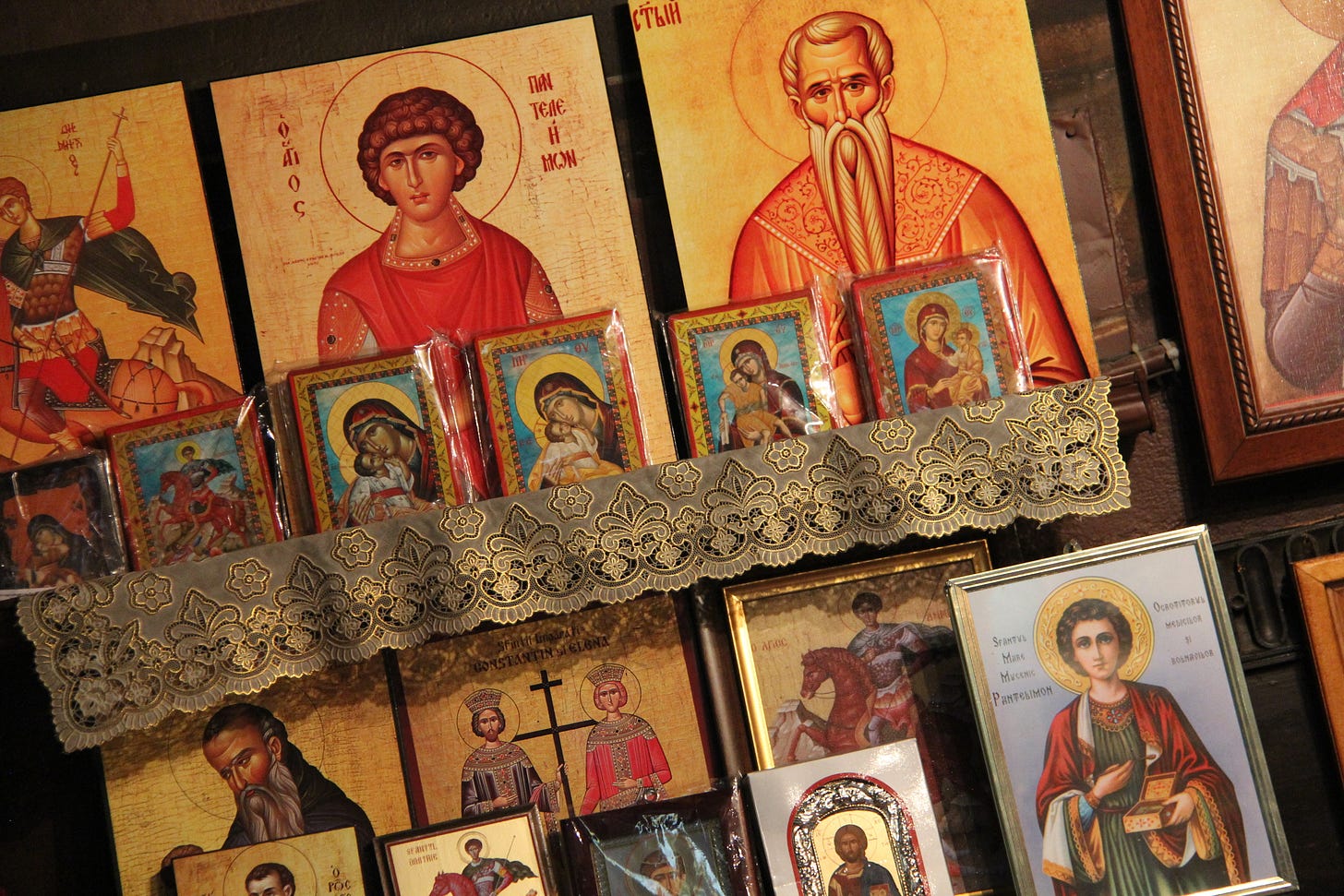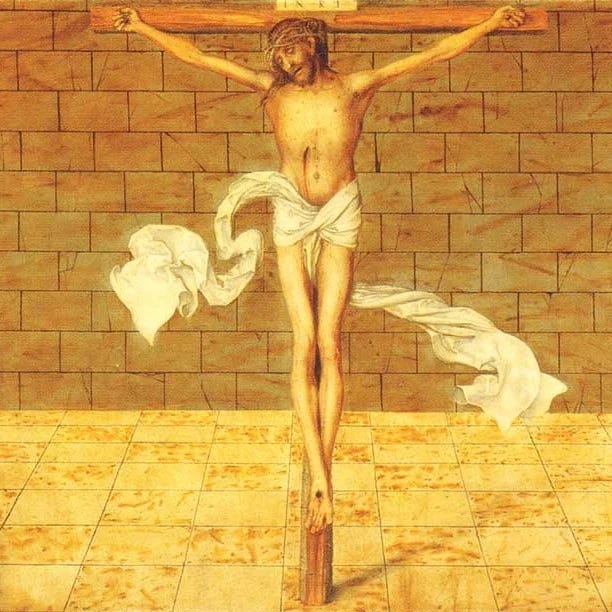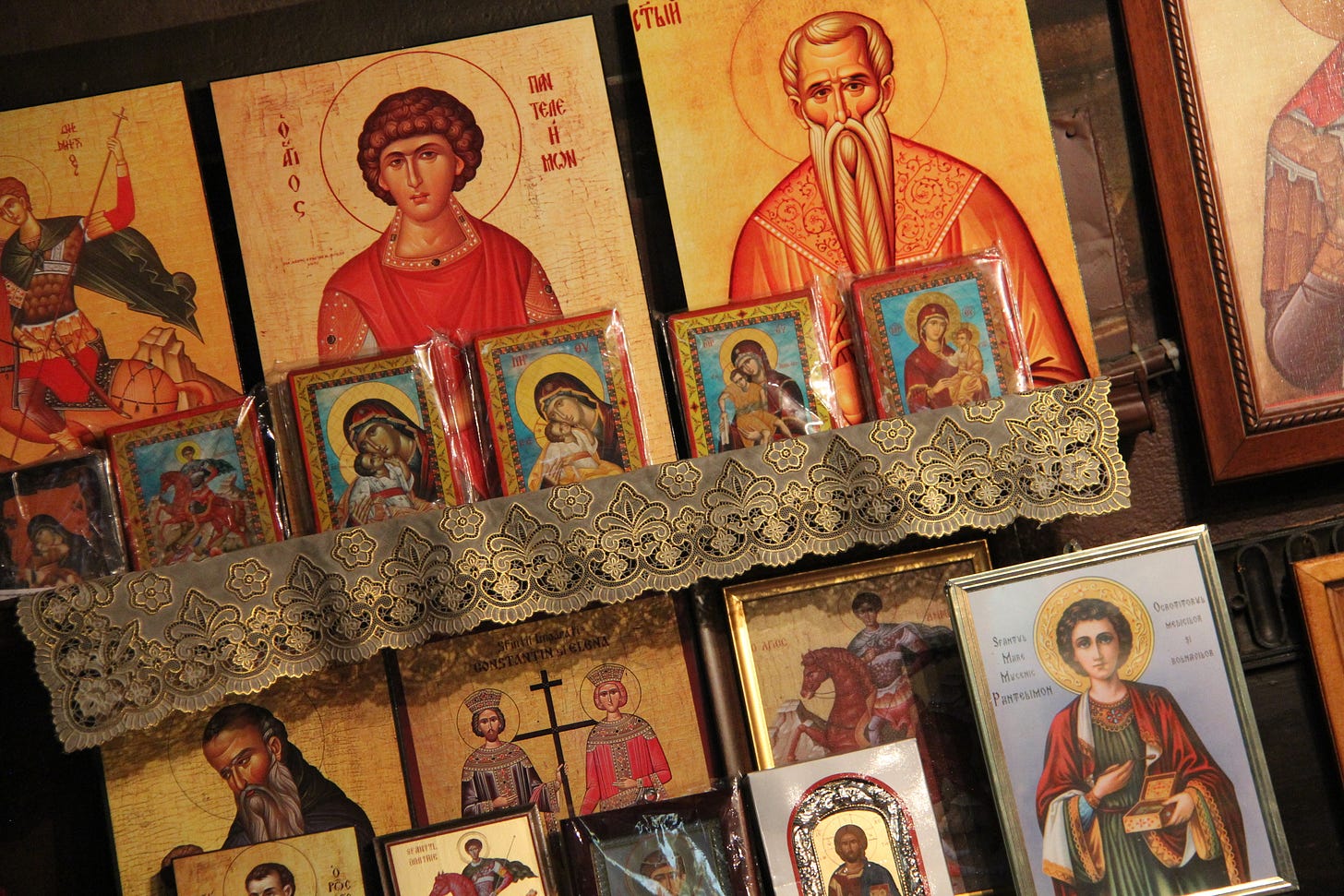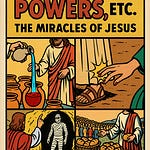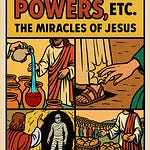All Saints— Revelation 19.11-16
Last year, during Advent, after the Christmas Pageant, one of the children in the cast came up to me in the fellowship hall.
“I have a question,” she said.
“What’s your question?”
“So…Jesus is alive?”
I nodded.
She thought about it for a moment. Clearly this hadn’t been her question.
“Well, if Jesus is alive, then how come we can’t see him?”
I knelt over and leaned in towards her and I whispered, like this was a secret too special to share.
“Actually,” I said, “you can see him; in fact, you did see him just last Sunday.”
“I did?”
I nodded.
“Yes, of course,” I said, “He was that bread on the table and the cup next to it. And all of us gathered around him in praise and petition. Jesus is alive and that’s the form— one of them, anyway— his body takes now.”
She nodded.
“Is that true,” she asked.
“What if it is true?” I replied, “What would it mean?”
She thought for a beat.
“I guess it means there isn’t much difference between there and here.”
“What do you mean?”
“That there isn’t much difference between the there where God is and here where we are. Like, we don’t have to go very far to find love.”
Someone asked me this week, “Why do we do celebrate communion every Sunday?”
“Because John Wesley so instructed us,” I answered, “People accuse me of being insufficiently Methodist but I’m more Methodist than any of you.”
“Why did John Wesley instruct us to celebrate constant communion?”
“Because the Lord Jesus joins us at the table,” I said, “He is us at the table.”
The only body of the risen Christ to which the New Testament ever refers is not an entity in heaven but the Eucharist’s loaf and cup and the church assembled around them.
“You are the body of Jesus,” 1 Corinthians implores us to remember.
And the teaching there is a proposition and not trope. “The cup of blessing that we bless, is it not a participation in the blood of Christ?” the apostle Paul writes in the epistle, “The bread that we break, is it not a participation in the body of Christ? Because there is one bread, we who are many are one body, for we all partake of the one bread.”
Again, we are “one body” in that we do something that can equivalently be described as “sharing in the body of Christ” and partaking of “the one bread.”
“The church is his body,” Ephesians says, “the fullness of him who fills all in all.”
Scripture demands nothing less than that you reconfigure your definition of what constitutes a body.
The body of the risen Lord just is those believers who are baptized into him gathered around the loaf and the cup in praise and petition.
The bread that we break and the cup that we bless is, as Martin Luther insisted, the gate of heaven.
Jesus is here.
You can see God.
And if this is the gate of heaven, if Jesus is present and available to us in the bread that we break and the cup which we bless, then likewise present and available to us are all those who have died in Christ.
Thus we pray, “And so, with your people on earth and all the company of heaven, we praise your name and join their unending hymn.”
This is the gate of heaven. The Lord Jesus is here. For you.
But so are all his friends, Joseph and Liz and Gary and Jeanne and John…
I know some of you are just going through the motions.
But imagine if it were true.
The journalist William Dalrymple wrote a travelogue of Christians in the Middle East called From the Holy Mountain, in which he tells an anecdote about the monks at St. Anthony’s Monastery in Middle Egypt.
St. Anthony was the Christian tradition’s first hermit.
William Dalrymple visited St. Anthony’s cave and met the monk, Father Dioscuros, who told Dalrymple a story about the body of Jesus and the communion of the saints:
“You won’t believe this”—here Fr. Dioscuros lowered his voice to a whisper. “You won’t believe this, but we had some visitors from Europe two years ago—Christians, some sort of Protestants —who said they didn’t believe in the [communion of the saints]” The monk stroked his beard, wide-eyed with disbelief.“No,” he continued. “I’m not joking. I had to take the Protestants aside and explain that we believe that St Anthony and all the fathers and mothers have not died, that they live with us, continually protecting us and looking after us. When they are needed—when we go to them at the altar—they appear and sort out our problems.”
“Can the monks see them?”
“Who? Protestants?”
“No. The deceased, the saints. . . .”
“Well, take last week for instance. The Bedouin from the desert are always bringing their sick to us for healing. Normally it is something quite simple: we let them kiss an icon, give them an aspirin and send them on their way. But last week they brought us a small girl who was possessed by a demon. We took the girl into the church, and as it was time for vespers one of the fathers went off to ring the bell for prayers. When he saw this the devil inside the girl began to cry: ‘Don’t ring the bell! Please don’t ring the bell!’ We asked him why not. ‘Because,’ replied the devil, ‘when you ring the bell it’s not just the living monks who come into the church: all the holy souls of the saints join with you too, as well as great multitudes of angels and archangels. How can I remain in the church when that happens? I’m not staying in a place like that.’ At that moment the bell began to ring, the girl shrieked and the devil left her!”
Father Dioscuros clicked his fingers: “Just like that. So you see,” he said. “That proves it.”
“Proves what?”
“That just as the church fathers taught, the separated souls are hanging out around the altar because the consecrated bread and wine of the Eucharist—the post-resurrection body of Christ—are the closest they can get, until the general resurrection, to getting their bodies back.”
There is a portion of the church which awaits the Kingdom not on earth but in heaven.
The fellowship of the baptized, because it is a communion of God’s eternally, life-giving Spirit, cannot be broken by time’s discontinuities, particularly not by death.
Thus, the church is a single, active communion across time of living believers and perished saints.
The communion of the saints is a communion across time; therefore, the communion of saints includes, even, your future self and, indeed, those saints not yet born.
Register the claim—
At table, around loaf and cup, we commune with people not yet born.
All Saints is not the remembrance of the dead.
All Saints is the celebration of those who are alive now only in Christ— and their availability to us.
All Saints is not the remembrance of those who have departed.
All Saints is the celebration of those who are here— and their power to minister to us.
This is the logical, sequential connection in the creed between the communion of saints and the forgiveness of sins, Maximus the Confessor teaches. The forgiveness of sins is not an item of the past but ongoing present labor. Contrary to Charles Wesley’s hymn, they are not at rest. We still sin against one another, and those who are now alive only in Christ are at work, in and with the Lord, to restore all things.
Scripture claims nothing less than this when it teaches that our faith directed at the Lord Jesus is simultaneously love directed at all the saints.
The claims of scripture are astonishing if we can learn not to look the other way.
All Saints is not the remembrance of those who have gone.
All Saints is the celebration of those who are here.
Here— present with the Lord Jesus.
We are not alone.
You are not alone.
The saints are the light we cannot see.
Not only are we responsible for one another, there is a vaster number still who are responsible for us. As Jonathan Edwards writes, “The church in heaven and the church on earth are more one people, one city and one family, than generally is imagined.”
All Saints is not the remembrance of those who have gone.
All Saints is the celebration of those who are yet here.
And though we may not always see or hear the saints, they know us infinitely better than we know ourselves exactly because their knowledge is a participation in the Lord’s knowledge of us.
When I was a boy, during the years when my father’s disease was at its nadir and he was seldom at home and my mother worked the night shift, I had a respite of sorts at my grandparents’s home.
I walked to their house from school, and they played with me and fed me and watched game shows with me and put me to bed.
My grandmother Theresa was an Italian immigrant and, like so many, a cook.
So far as I know, my grandmother did not attend Mass.
But she did have a portrait of Pope John Paul on the wall near the kitchen.
And the bed into which she tucked me had mounted above it a frighteningly large, baroque crucifix. And she prayed.
Theresa may not have been a churchgoer, but she was a praying woman.
Every night that she put me to bed, she would smooth my hair and pray the Our Father over me and then, as a sort of benediction, she would say, “We’re here. We’re here for you.”
To paraphrase Cormac McCarthy, if my grandmother's words were not, for me, the word of God, then God never spoke.
When I was in junior high, Theresa joined what Hebrews calls the “great cloud of witnesses.” Eighteen years ago, at my ordination service, I knelt before the bishop who stood beside the loaf and the cup on the altar as the body of believers gathered around us. And as the bishop laid hands on me to consecrate me to this bewildering, ill-fitting vocation, I suddenly had this apprehension— this vision and audition— of my grandmother Theresa.
And I heard her as clearly as I heard you all earlier profess the creed.
She said to me, “We’re here. We’re here for you.”
Those who have died in the Lord are not departed.
Not only are they not gone, the Lord is not done with them.
The verse in the Book of Hebrews that immediately precedes the description of the great cloud of witnesses says, “Only together with us will the saints be made perfect.”
It’s astonishing how we read right past the astonishing claims of scripture.
The saints are not gone but neither are the saints yet fully sanctified.
Which is also to say, the dead who have died in the Lord are not merely alive.
They are more alive than we are.
The same passage in Corinthians:
When Paul gives the church instructions for celebrating the Eucharist, how does he introduce the sacrament? After all, Saul was not present at the last supper. Paul doesn’t say to the Corinthians, “As I read in the Gospel of Matthew.” Paul did not have the New Testament. Nor does Paul write, “This is what the other apostles have shared with me.” No, Paul testifies, “For I received from the Lord what I also delivered to you…”
Paul learned the Eucharist, so to speak, from Saint Jesus.
All Saints is not the remembrance of those who have gone.
All Saints is the celebration of those who are yet here.
We are not alone.
There is more to reality than what we can make out.
There is a reality that is deeper than the darkness we can see.
In an essay entitled “What If It Were True?” Robert Jenson writes:
“There is a reason for our skittishness with the gospel’s truth claims…So soon as we pose the question, “What indeed if it were true?” about any ordinary proposition of the faith, consequences begin to show themselves that go beyond anything we dare to believe…The most Sunday-school- platitudinous of Christian claims say, ‘Jesus loves me’ contains cognitive explosives we fear will indeed blow our minds…
Let me give a prolegomenal instance. We sometimes join our daughter’s family for the main Sunday Eucharist at New York’s cathedral of St. John the Divine. Besides seeing our family, we go there because what happens of a Sunday morning often makes an occasion within which we can credit biblical stuff that stumps us in other contexts. For our time’s sake I will stick to what the cathedral’s organist, the amazing Dorothy Pappadokos, does. While her French-style improvisations are shaking the stones of the building, and my stony heart, when climax upon climax each improbably eclipses its predecessor, I am able to sustain the notion that all God’s various holy ones are gathered there with us, that in fact we are praising God, as the liturgy of my church has it, “with angels and archangels and all the company of heaven,” that if only we could see what is actually there, we would see the mighty thrones and dominions and Mary and Paul and Olaf and my father-in-law and so forth around us in the cavernous spaces.
But sitting in front of my computer to write for publication, I chicken out, and begin looking for ways to pare down the proposition [according to] modernity’s prejudices…And of course it is a mind-bending exercise to consider in what mode dead believers make one living company with living ones, but do they or don’t they? Is Papa Rockne there for our Eucharist or is he not?” If we say yes, then we must repent of all our assumptions about what constitutes the “real world.”
War in Israel, fear amongst Jews, grieving in Gaza, despair in Ukraine, dysfunction in Washington, a lethargic pace of change in the UMC, a burning planet, your breaking marriage, the Big Lie— nevertheless; there is a reality afoot that is deeper than the darkness we can perceive.
There is light we cannot see.
This is the central, abiding announcement not just of this passage but of the entire Book of Revelation. Here in chapter nineteen, John simply sees what we say in the second article of the creed about Jesus sitting at the right hand of the Father. John sees Jesus not as the Son of Man from Revelation 1 or Jesus as the slain Lamb from Revelation 5.
John sees the Lamb is a Lion.
The Pale Rider is Christ the King.
More to the point, the array of names in chapter nineteen (Faithful and True, Word of God, A Name No One Knows But Himself) is but an indication that the Christ who is King is none other than The Name— HaShem— who encounters Moses in a bush that was ablaze but not consumed by it.
Jesus of Nazareth is the God of the exodus.
This just is what John sees.
And Jesus is judging with justice.
He is fighting for righteousness.
And he is so right now, the Spirit shows John.
That is, no matter what the headlines say, no matter what your eyes can see, no matter what your faith can perceive, the earth’s truer reality is that the Lord Jesus is King.
In this regard, it makes all the difference that chapter nineteen comes before chapter twenty. The Spirit shows the prophet the Lordship of Christ over the earth not as the product of evil’s demise but as the precursor to it. The Last Battle with Satan does not come until the end of chapter twenty but already in chapter nineteen Christ is King.
There is a reality afoot that is deeper than the darkness we can see.
Jesus is Lord.
And, as surely as I heard my grandmother, the Lord Jesus and all the company of heaven are speaking to us, “We’re here. We’re all here.”
Just last Sunday, a friend of mine, a Christian who lives in Northern Israel, emailed me to say, “My mother and father died ten years ago. Yesterday they appeared to me in my dream and they told me to tell you that they’re praying for you. They said your name, Jason. How on earth do they know you unless it is all true?”
She underlined that last clause.
Once you ask Jenson’s question, “What if it were true?” once you give Christians permission for their Christianity to be weird, you hear stories like this all the time.
Stories like this story a former parishioner sent me:
“Almost thirty years ago, our son was a teenager. He was troubled. We were able to get him registered in a prep school in New England. But during orientation, he ran away into the streets of Portland and was missing for days. Both my wife and I were worried sick had been praying that he would be okay. On the third day, I had been listening to religious music in my car, and there in my vehicle, in the dark and in silence, I heard my son’s voice say— I heard my future son’s self say, “Everything is going to be ok.” Those six little words from beyond what we can see pulled us through an awful time.”
Nothing that is possible can save us.
Once you ask Jenson’s question, “What if it were true?” once you allow Christianity to be weird, you can discover a reason for actual hope.
In that same essay, Jenson writes:
“It makes a difference. What do we think we inhabit? A machine of some sort? If so, we are victims of an illusion. What we really inhabit is rather a drama, the drama of Israel’s God…
It makes a difference. I do not know if our culture can be rescued from the superstition that recognizes only sub-personal forces as finally real.
If it cannot be rescued from that illusion, we will, for but one matter, continue so to present reality to students in the schools as to persuade them of their own meaninglessness and of the inconsequence of all their actions. I acknowledge that left to myself, I would despair. But since we are not left to ourselves. who knows? The church, anyway, must fight in all the ways she can against the realization of the Clockwork Orange also in her own life.”
All Saints is a way we fight against the Clockwork Orange. All Saints is a way we fight against the resignation that only what we can see is real. Allow me to throw a punch in the fight.
In the Book of Malachi, Jesus speaks to the prophet, telling him to exhort God’s people to remember the commandments given to Moses. But— Jesus cautions Malachi— even if the people do keep the law, I am sending Elijah to convert the hearts of generations.
Elijah is but one of the saints.
In other words— and, again, it’s weird— Jesus dispatches the saints from the Last Future back through time to turn hearts towards him.
Which means nothing less than…
My grandmother did not say, “We’re here. We’re here for you,” merely to steady me in the midst of a turbulent childhood.
Rather, Saint Theresa gave those words to my grandmother so that I would apprehend them at my ordination.
Still further, Saint Theresa gave those words to my grandmother to speak over me as a boy; so that, today I could relay them to you and with them, through them, you would know that everything is going to be okay.
No matter how dark the world may appear, the light is winning.
What if it were true?
For starters, there would be no reason you would not rush. Run straightaway to the table. With God, there is no here and there. There is only ever here. Therefore, you don’t have to go very far to find love.




